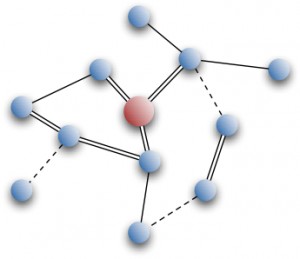Building the Social Capital of Leaders
by Rik Nemanick, Ph.D.
One of the more valuable assets possessed by both leaders and organizations is social capital. Social capital can be thought of as the benefit created by leveraging network of relationships to achieve positive results. Individuals can be said to possess social capital based on the scope and the strength of their personal networks. Organizational social capital is the sum total of the number and strength of connections that exist among the people within the organization. Unlike other forms of capital, social capital is not depleted by use, but in fact depleted by non-use (“use it or lose it”). Additionally, unlike physical assets, social capital is more difficult for competitors to see and to imitate.
It isn’t hard to think about times organizations have suffered from a lack of social capital: when conflicts develop across company silos; when action is delayed because a key stakeholder was left out of the decision making; or, when an employee with high potential leaves because she doesn’t see the career options at the company that others could have shown her. The fact that the impact of social capital in these instances is not obvious is what makes it so valuable. Each of these situations could have had a number of causes, but each may have been different had a stronger network of connections existed within the organization.
Strong social capital benefits the organization by facilitating the flow of information and resources, especially across silos. By easing the flow of information, organizations more easily identify and react to opportunities and threats, facilitate change, and create a more cohesive teams. When the volume of social capital is low, information can pool within certain parts of the organization, but fail to flow to other parts where it may be beneficial.
Leaders benefit from social capital through their ability to influence others, to collect information that is important to them and their teams, and to communicate across organizational barriers. Individuals benefit from the information and ideas that flow to them and from them, connecting them to the larger network within the organization.

Sociogram
There are two basic components in the measurement of social capital. First, is the sheer number of contacts in your network and second is the relative strength of each of those network ties. In his book, The Tipping Point, Malcom Gladwell describes the benefits of both a large number of “loose ties” and a small number of “strong ties”, where each can add value depending on how they are used. A leader with lots of loose ties can tap his network to locate important information or important decision makers. A leader with a small number of strong ties can engender more trust and make larger requests of those in her network. A particularly useful tool in the measurement of social capital is the sociogram (shown at right). A sociagram depicts both the number and strength of network ties that an individual possesses. Sociograms can also be enhanced to show the strength of the social capital in an organization (you can read work by Rob Cross about his network analysis framework for studying social networks).
Some leaders build their social capital naturally and use it to accomplish goals without thinking about it. Others fail to recognize how their lack of social capital inhibits their ability to get things done. Leveraging social capital requires individuals to expend effort to acquire the capital and attention to maintaining the capital once it is acquired. To improve your use of social capital, it is helpful to examine your network of connections with the following questions in mind:
- Are there holes in my network that I need to fill?
- What parts of my network that have been neglected and may be becoming weaker?, and
- How am I helping others build their networks?
The last point is important to think about, especially for leaders and mentors. One of the best ways to leverage your own network is to help others tap into it. Opening your network to others can engender reciprocity and strengthen ties with those you help.
If you want to enhance your social capital, start by thinking about which strategy fits better with your style: a large number of loose ties or a smaller number of strong ties. Then, consider the state of your network to identify what you need to do to strengthen it. Next, decide what you need to do to reinvigorate your network (e.g., take someone to lunch you haven’t seen in a while or sending an e-mail update to a portion of your network who haven’t heard from you lately). Finally, consider what you can do to help grow another’s social capital, as these investments can pay some of the greatest dividends.
